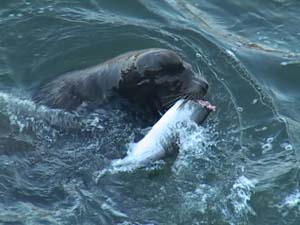forum
library
tutorial
contact

Dam Agreement to
Save Fish Worth a Try
by Editorial Board
Walla Walla Union-Bulletin, December 19, 2018
|
the film forum library tutorial contact |

|
Dam Agreement to
by Editorial Board
|
This plan, which does have risks, could work and
it has the potential to save money and end litigation.
 The seemingly endless debate over how to best save Pacific Northwest salmon, while maintaining Columbia and Lower Snake River dams and the shipping of grains and other commodities it allows, has yielded little but frustration.
But this week a compromise was reached and a deal struck that is expected to change how water is spilled at the dams as a way to boost the survival of young salmon (and, as an extension, help orcas that feed on them). At the same time, this plan is expected to limit the reduction (and lost revenue) of hydropower.
The seemingly endless debate over how to best save Pacific Northwest salmon, while maintaining Columbia and Lower Snake River dams and the shipping of grains and other commodities it allows, has yielded little but frustration.
But this week a compromise was reached and a deal struck that is expected to change how water is spilled at the dams as a way to boost the survival of young salmon (and, as an extension, help orcas that feed on them). At the same time, this plan is expected to limit the reduction (and lost revenue) of hydropower.
On Tuesday an agreement was recorded between states, tribes and federal agencies in U.S. District Court in Portland. It is set to begin for the 2019 salmon migration season and continue through 2021.
While it is far, far too early to know whether this move will result in more salmon returning to the ocean, it's got enough promise to give it a try -- and it is far better than battling in court rooms or Congress.
Under the agreement, according to The Seattle Times, the spill rate would be increased during the times of day when power is not in highest demand, and generating it is not as profitable. During the most profitable hours, typically during the mornings and evenings, spill would be reduced. The idea is to help salmon with higher spill, while keeping lost-power generation costs at, or potentially even below, current levels, the newspaper reported,
Keep in mind, however, that increased spills over dams can harm fish as gases -- including oxygen, carbon dioxide and nitrogen -- are generated that result in fatal symptoms similar to when human deep-seat divers get the "bends."
In a joint statement released Monday, U.S. Reps. Cathy McMorris Rodgers, R-Spokane, and Dan Newhouse, R-Sunnyside, challenged the benefits of spills and warned of harm to salmon.
The two members of Congress could well be right. This concern should be watched closely.
Nevertheless, the reality is that without an agreement litigation would continue and millions of dollars would continue to be wasted.
Bonneville Power Administration Administrator Elliot Mainzer said the agreement is an opportunity for an important change in direction on what has been a divisive issue, The Seattle Times reported.
People "who historically have been on opposite sides of the table" found common ground on how to improve salmon survival and help the BPA take advantage of new opportunities in a changing energy market that will improve the economic viability of the hydropower system, he said.
"When you get both of those things, it's a huge win-win," Mainzer said. "It is such a great opportunity to bring the region together ... We hope that we can do things differently going forward."
Helping salmon survive without tearing down dams, gutting hydropower production and eliminating river barging is, and should remain, the ultimate goal. Dam agreement to save fish worth a try.
learn more on topics covered in the film
see the video
read the script
learn the songs
discussion forum
